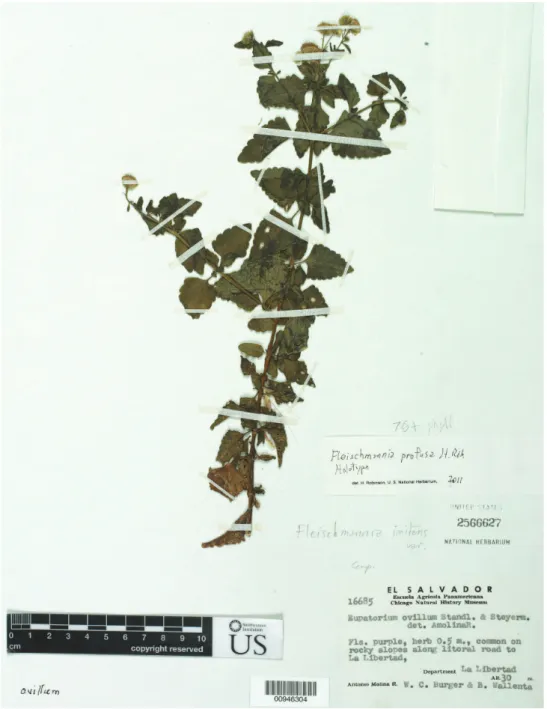A new species of Fleischmannia (Asteraceae, Eupatorieae) from El Salvador 37
A new species of
Fleischmannia
(Asteraceae,
Eupatorieae) from El Salvador
Harold Robinson
Dept. of Botany, MRC 166, National Museum of Natural History, P.O. Box 37012, Smithsonian Institution, Washington D.C. 20013-7012
Corresponding author:Harold Robinson (robinsoh@si.edu)
Academic editor:V. Funk | Received 14 September 2011 | Accepted 18 October 2011 | Published 29 November 2011 Citation: Robinson H (2011) A New Species of Fleischmannia (Asteraceae, Eupatorieae) from El Salvador. PhytoKeys 7: 37–40. doi: 10.3897/phytokeys.7.2088
Abstract
Fleischmannia profusa is named as new from El Salvador based on material with deltoid leaf blades, numer-ous axillary fascicles of leaves on the vegetative stems and c. 60 sharply obvinumer-ously acuminate involucral bracts in 4-5 strongly gradate series.
Keywords
Fleischmannia, Eupatorieae, Asteraceae, Mesoamerica, El Salvador
Introduction
Since the redeinition of the limits of the genus Fleischmannia Sch.Bip. (King and Robinson 1966, 1970) numerous studies have added species to the genus for the Flora Mesoamerica area (King and Robinson 1972, 1974, 1975, 1978, 1991; Robinson 2001). A further revision of the manuscript for the Eupatorieae of Mesoamerica has revealed an additional distinctive species of Fleischmannia in need of description. he species is named “profusa” because of the numerous small axillary fascicles of leaves on the vegetative stems and because of the numerous sharply pointed involucral bracts in many gradate series. his new species is described below.
PhytoKeys 7: 37–40 (2011) doi: 10.3897/phytokeys.7.2088 www.phytokeys.com
Copyright Harold Robinson. This is an open access article distributed under the terms of the Creative Commons Attribution License, which permits unrestricted use, distribution, and reproduction in any medium, provided the original author and source are credited.
rESEArCh ArtIClE
Launched to accelerate biodiversity research
Harold Robinson / PhytoKeys 7: 37–40 (2011)
38
taxonomy
Fleischmannia profusa H. Rob., sp. nov. urn:lsid:ipni.org:names:77115898-1
http://species-id.net/wiki/Fleischmannia_profusa
Figure 1
Type. El Salvador. Prov. La Libertad, Fls. purple, herb 0.5 m, common on rocky slopes along litoral road to La Libertad, alt. 30 m, s.d. A. Molina, W.C. Burger & B. Wallenta 16685 (holotype US, isotype F).
Ab species Fleischmanniam aliam omninoin phyllariis numerosis 4-5 seriatis ar-gute acuminatis distincte gradatis difert.
Branching herbs to 0.5 m; stems hispidulous with minute erect stipitate glands, glabrescent below; internodes mostly 1.5-2.0 cm. Leaves opposite, with numerous fas-cicles in axils; petiole 3-6 mm; blade mostly 2.0-3.2 × 1.4-2.3 cm, deltoid, trinervate from base, surface with few to many minute stipitate glands, without glandular dots, adaxial surface sparsely pilose, base broadly subtruncate, margins 5-8-crenate beyond widest part, apex short-acute. Capitulescence of 1-5 capitula terminal on main stem and branches, subtended by sparse narrow bracteoles 3-7 mm; peduncles 0.6-1.0 mm, with minute stipitate glands. Capitula 6-7 mm; phyllaries c. 60, subimbricate, graduate in c. 4-5 series, lanceolate, 1.5-4.0 × 0.4-08 mm, all narrowly acute to slightly acumi-nate, green, scarcely scarious, with many minute stipitate glands. Florets c. 60; corollas c. 3 mm, purple, lobes c. 0.4 mm, with few or no small trichomes; style branches not broadened distally. Cypselae c. 1.5 mm, black with black ribs at maturity, scabrid on ribs; pappus with c. 20 bristles 2.5-3.8 mm, slightly non-contiguous at base. Common on rocky slopes along litoral road, 30 m. ES (Molina, Burger & Wallenta 16685 (US).
he type specimen was originally distributed from the Escuela Agricola Panamer-icana and the Chicago Natural History museum under the name Eupatorium ovil-lum Standl. & Steyerm, a completely diferent species now known as Ageratina ovilla
A new species of Fleischmannia (Asteraceae, Eupatorieae) from El Salvador 39
Harold Robinson / PhytoKeys 7: 37–40 (2011)
40
he distinctions between Fleischmannia profusa and F. imitans in couplet form are as follows:
1 Leaves ovate-lanceolate to lanceolate; phyllaries 35-40 in c. 3 weakly subim-bricate series, appearing supericially eximsubim-bricate; stems with few or no axil-lary fascicles of lealets ...F. imitans
– Leaves deltoid; phyllaries ca. 60 in c. 4-5- gradate distinctly subimbricate series; stems with many axillary fascicles of lealets ...F. profusa
references
King RM, Robinson H (1966) Generic limitations in the Hofmeisteria complex (Compositae-Eupatorieae). Phytologia 12: 465–476.
King RM, Robinson H (1970) Studies in the Eupatorieae (Compositae). XVIII. New combina-tions in Fleischmannia. Phytologia 19(4): 201–207.
King RM, Robinson H (1972) Studies in the Eupatorieae (Asteraceae). CI. New species of
Fleischmannia and Neomirandea. Phytologia 24(4): 281–284.
King RM, Robinson H (1974) Studies in the Eupatorieae (Asteraceae). CXXI. Additions to the genus Fleischmannia. Phytologia . Phytologia 28(1): 73–96.
King RM, Robinson H (1975) Studies in the Eupatorieae (Asteraceae). CXLVI. Two new spe-cies of Fleischmannia from Central America. Phytologia 31(4): 305–310.
King RM, Robinson H (1978) Studies in the Eupatorieae (Asteraceae) CLXIX. Two new spe-cies of Fleischmannia from Guatemala. Phytologia 38(5): 417–423.
King RM, Robinson H (1991) Two new species of Fleischmannia from Mesoamerica (Eupato-rieae: Asteraceae). Phytologia 71(3): 181–183.
